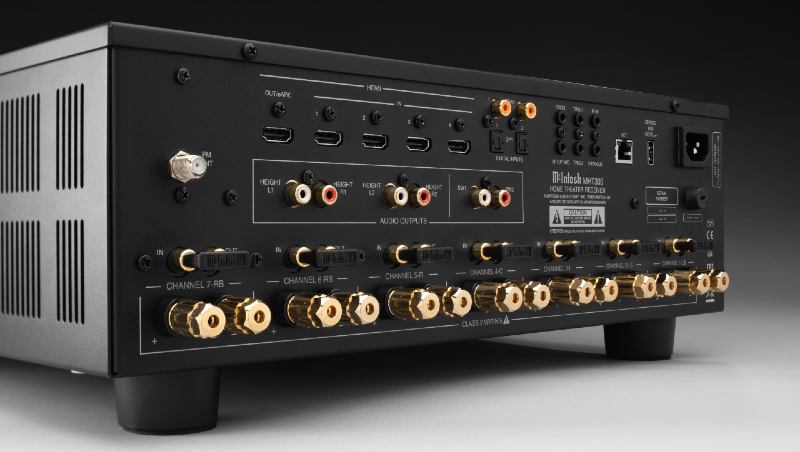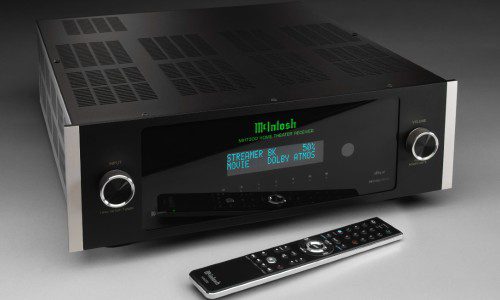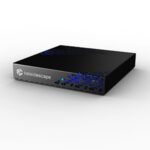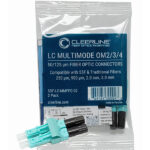“My system just doesn’t sound as vibrant as it did in the showroom.” “I can’t really understand the dialog clearly all the time, why is that?” Do these home theater customer complaints sound familiar? If so, it might be time to level up with a more powerful home theater receiver that can address those issues and much more.
Ken Zelin, global training manager at McIntosh, says dynamic range and clarity greatly impact those two areas of concern, and toward that end the new McIntosh MHT300 Home Theater Receiver focuses on delivering more power while maintaining low distortion.
Add in the inclusion of Dirac Live room correction software, 8K video switching, immersive audio support, availability of pre-amplifier output/main amp input jacks and more, and the result is a premium, made-in-the-USA component that’s been a long time in the making.
“This is the no-apologies receiver. I want everyone to say, ‘This is what we’ve been waiting for,’” Zelin says of the MHT300 (MSRP $8,000), which is the company’s first new home theater receiver in many years following predecessors MHT100 and MHT200.
Let’s take a closer look at key reasons why integrators “have been waiting for” an AVR like the McIntosh MHT300.
McIntosh HT300 Receiver Solves the Problem of AVR Power
“I constantly hear from people two things – my system in my home doesn’t sound as alive as it did in the store, and that’s usually because in the store they audition their speakers using a big powerful power amp and what they ended up buying was a receiver. And the other complaint is I can’t understand the words clearly, and that’s because when distortion starts going over .5%, clarity suffers,” Zelin explains.
Employing Class D amplification, McIntosh rates the 7.2.4-capable MHT300 to produce 120 watts per channel (wpc) into 8-ohm loudspeakers with all seven channels being driven, and 150 watts per channel into 4-ohm speakers. The company rates those specs across the human hearing range of 20Hz to 20kHz, and with a very low .03% distortion.
Meanwhile, the MHT300 will handle the biggest action scenes, orchestral crescendos and other high-impact moments unlike other home theater receivers. It packs in >3dB of dynamic headroom, delivering more than 300 watts per channel available on peaks. “That’s a whole lot of power,” Zelin says.

Zelin implores integrators to examine AVR specs more closely in general when it comes to power. He notes that many AVR manufacturers offer no 4-ohm power rating; they may provide power ratings only at only one frequency perhaps when going from 8 to 6 to 4 ohms; or show distortion percentage climbs, while watts per channel declines significantly, when more channels are driven. Meanwhile, the MHT300 actually increases from 120 to 150 wpc when more power-hungry 4-ohm speakers are used, he notes.
“It’s important for integrators to look at specs and check for ratings listed for two-channels vs. all-channels driven,” Zelin says. “When we say it’s 150 wpc into 4 ohms across all the frequency range with low distortion, with all speakers going… that’s a radically more powerful receiver. It’s a receiver that isn’t going to sound like a receiver, it’s going to sound like separates.”
McIntosh’s patented Power Guard technology helps the MHT300 achieve its impressive power ratings by preventing the sound signal from clipping. The MHT300 can employ Class D without worrying about clipping issues.
“Class D amplifiers can sound wonderful – they run cool, they’re reliable. The one disadvantage is when you overdrive an amplifier past its limits and that’s called clipping,” Zelin explains. “We took the one disadvantage of Class D and wiped it off the map.”
MHT300 Integrator-Friendly Setup & Installation Features
Meanwhile, Zelin points to additional features that make the MHT300 appealing to the custom integrator channel, from its support of the latest AV formats to its ease of configuration to its flexibility to add even more power as the foundation of a high-performance home theater system.
Regarding the latter, the McIntosh AVR includes pre-amp outs/main ins, something Zelin says enables integrators to add a 4-channel amplifier in a couple of different scenarios. That could mean adding or upgrading power to height or surround channels, for instance, or perhaps adding separate bigger monoblocks for front left/right speakers and engaging those now unused channels on the MHT300 for height or surrounds.
“When home theater receivers first came out, they all had this feature but now it’s taken off to save money,” Zelin says. “We’ve got it built in, so you never have channels sitting there wasted – installers are going to love that.”
The MHT300 has been engineered as an audiophile-grade home theater receiver, so room correction software has been upgraded to Dirac Live, while analog has been removed from the equation. All audio inputs are digital (two coaxial, two optical) and there are no composite or component video inputs. The MHT300 features 8K switching and four HDMI 2.1 inputs (and one HDMI output with eARC) to handle 4K and 8K video.
Being purpose-built as a receiver for audio enthusiasts but future-proofing for video led McIntosh to include Dirac Live as the premium advanced room correction software, one whose sophistication requires hefty computing power. It’s another differentiator between the MHT300 and less-powerful AVRs – in both wattage and processing, which also includes a 32-bit DAC for upsampling to and reproducing high-resolution audio. Dirac, a Swedish company, is renowned for its granular equalization and room acoustics capabilities.
“In the past we used Audyssey, which senses how far apart speakers are, but didn’t really correct for room acoustics in a very sophisticated way. What Dirac Live does is it analyzes the room and really pinpoints things,” Zelin explains. “If it knows we have a boom in the bass, instead of just reducing the bass, it figures out that the boom is from the right back corner and it’s being caused by the left front speaker, for instance. And it corrects just that speaker – it’s got a lot of smarts to it.”

Beyond the ability to dial in a home theater’s audio with leading software, McIntosh made the MHT300 much simpler for integrators to set up than predecessor AVRs. Gone are the tedious setup steps for renaming sources or other information by fumbling around with remote control arrow keys and on-screen menus – now installers can do everything via laptop.
“If you wanted to rename any inputs you know how difficult it is – up, down, left, right, find the letter, enter, repeat. With the MHT300 you don’t have a remote control to set it up, this has been designed right from the top down for laptop setup, which is a 1000x easier,” Zelin explains.
Integrators connect the MHT300 to the network via Ethernet (or installers can use a wireless adapter, widely available on the market), hardwire their device to the receiver, turn a knob on the front, press a button and it provides the IP address, which they can type into the browser on a laptop or Mac. “And there’s your on-screen menu,” he says, “but the beauty is when you want to rename an input Video 3 to DirecTV let’s say – you just type in DirecTV.”
Once a setup has been created for a system, installers can use it as a template for the next project that employs an MHT300, Zelin adds. To ensure the receiver will fit beautifully into an equipment rack for your next home theater build, McIntosh even ships the MHT300 Home Theater Receiver with rackmount ears in the box, so it looks like a well-finished faceplate – the latest component adorned with a logo that’s been synonymous with audiophile for nearly 75 years.
To learn more about the MHT300, visit McIntosh’s website.















